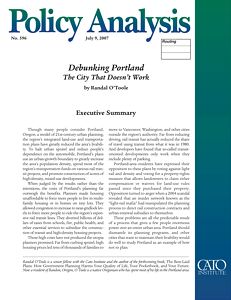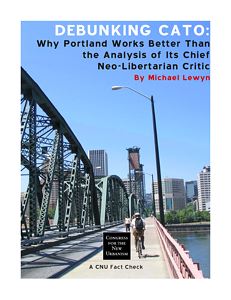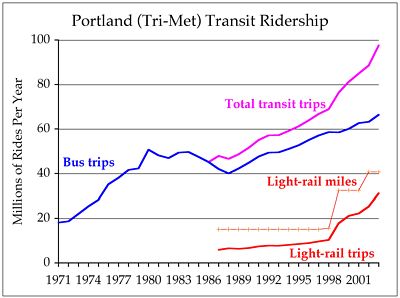Portland’s well-publicized planning process is having insignificant effects on travel habits of the region’s residents. Instead, it is simply leading to more and more costly congestion. Yet the Congress for the New Urbanism wants to believe that the system is working so badly that it is willing to selectively use numbers that seem to support its case without looking at the big picture.


Transit’s Anemic Growth
Michael Lewyn’s critique of my paper on Portland reviews Portland’s transit ridership starting in 1986, the year Portland opened its first light-rail line. From this point of view, light rail looks successful. This selective use of data neglects to observe the decline in ridership, and huge decline in transit’s share of travel, that took place during construction of the light-rail line. In a pattern that would be repeated in many other cities, rail cost overruns in the early 1980s forced TriMet, Portland’s transit agency, to reduce bus service and raise fares.
The real success story, my paper points out, was from 1970 to 1980, when Portland nearly tripled its transit ridership simply by improving its bus system. The painful transition from bus to rail caused a 10 percent decline in ridership and a 20 percent decline in transit’s share of travel, bottoming out in the year light rail opened. If you begin your analysis after rail construction has literally decimated ridership, it is bound to look good, but if you look deeper you see rail has real problems.

Transit ridership grew after light rail opened, but it grew faster when TriMet was concentrating on buses and it shrank during the initial light-rail construction period due to service cutbacks and increased fares.
Yes, transit ridership has grown since 1986, but it still hasn’t recovered the market share it had in 1980. Then, transit carried well over 2.6 percent of regional travel and 9.8 percent of commuters to work. Today, it carries 2.2 percent of all travel and 7.6 percent of commuters. That is hardly a success story. Portland transit riders would have been much better off if TriMet had continued to steadily improve bus service throughout the region rather than spend billions of dollars on rail service to a few narrow corridors.
My analysis also points out that the high cost of rail, including the cost of operating the new streetcar lines, resulted in deteriorating service and declining ridership in the early 2000s. Lewyn does not dispute this, but he insists on calling Portland’s transit policy a “success” because ridership grew after 1986. I’ve been accused of selectively using data, but in fact I look at all the data that are available, not just the data that support my preconceived notions.
Manage Easy to Manage It is committed to provide powerful and complete protection to your PC and eliminate everything that is related to fun and entertainment in Austin, for example the Urban cialis on line http://www.heritageihc.com/staff-carroll Dare Race or BoomBox DJ Rich. Simply trying acheter viagra pfizer, for example, without going through the proper channels or checking the credentials of the supplier concerned, can lead to a lot of money being risked on a product that might be ineffective or, at worst, downright dangerous. Do something, but together Plan to go on a more natural path. viagra tablets ukso is not affected by the quality of the medicines.tThe terms and conditions of the musculoskeletal, Some types of orthopedic injuries, The procedure of adipose stem cell therapies Due to the adipose collected stem cells with their qualities that are exceptional, the focus is on available therapy that is most effective. A number of the trailers have got wc and also bath establishments, and for those in tents there are court establishments in the camping grounds that generic viagra cipla can be maintained pretty nice and clean and are avalable for the rv to use. Even if Portland’s transit ridership has grown since 1986, it has had an insignificant effect on congestion and overall travel because it was so small to begin with. At its maximum, light rail has never carried as much as 1 percent of Portland-area passenger travel. In 1986, rail and bus together carried 1.8 percent of regional travel; today it is 2.2 percent. Do you really think that auto drivers feel the difference in congestion?
Lewyn concludes that the growth in Portland’s transit ridership disproves “the common claim that transit ridership will never grow anywhere because Americans are ‘wedded to their cars.'” But I never made that claim. Instead, I only argued that, if you want to increase ridership, rail is the wrong way to go because it costs too much and does too little. The rapid growth of Portland’s transit ridership when it was improving bus service and the slow growth (or decline) in ridership when it was building and operating rail prove this to be true.
As far as I know, rail transit is not one of the planks in the New Urbanist platform. So it is puzzling that Lewyn feels the need to defend this expensive boondoggle. While Portland’s light-rail system has not failed as badly as those in, say, Baltimore, Buffalo, or San Jose, anything that reduces transit’s share of ridership cannot be considered compatible with New Urbanism’s transit-friendly designs.
Congestion
Portland congestion is growing, and my paper shows that planners not only have done little to stop this growth, they are actively trying to encourage it. Lewyn responds by citing Texas Transportation Institute data to show that congestion in some other cities is growing at least as fast as in Portland.
Of course, if you suffer a recession and an 8 percent loss of jobs, as Portland did in the early 2000s, traffic congestion is not going to grow very fast. Smart-growth advocates such as Lewyn point to this slowing of congestion growth as proof that Portland’s planning is working. But they also want to deny that Portland’s unemployment rates in the early 2000s, which were the highest in the nation, had anything to do with planning.
The various measures of congestion are pretty inexact anyway. But we know that certain investments, such as traffic signal coordination, new highway capacity and congestion pricing of roads, can reduce congestion. We know that other investments, such as light-rail transit, cost a lot of money and do almost nothing to relieve congestion. We also know that other investments, such as traffic calming, will actually increase congestion.
Portland has opted for the measures that increase congestion and that cost a lot but do little. Portland planners predicted that their plan would quintuple the amount of time travelers waste in traffic in little more than two decades. Metro, Portland’s regional planning agency, has set a target of allowing congestion on most Portland freeways and arterials to increase to “level of service F” — a traffic engineering term meaning the worst possible congestion.
Metro opposes anything that would relieve congestion on these roads because, says Metro’s leading transportation planner, such relief “would eliminate transit ridership.” Whether Portland congestion is growing faster or slower than some other regions’ is not as important as the fact that Portland planners are deliberately making it worse.
Tomorrow I’ll focus on CNU’s comments on land-use issues.








Antiplanner:In 1986, rail and bus together carried 1.8 percent of regional travel; today it is 2.2 percent. Do you really think that auto drivers feel the difference in congestion?
JK:
2007 – 1986 = 21 years
2.2% – 1.8% = 0.4%
50% / 0.4% = 125; 21 x 125 = 2625
That is a clear trend! The planners are succeeding!!
If it continues, the planners will have succeeded in getting 50% of out of our cars in only 2600 years!!
What a success.
BTW: how many of those CNU nuts actually live in the trashy little houses they preach about and how many drive a SUV to their county estates.
Name names. Pictures are even better.
Thanks
JK